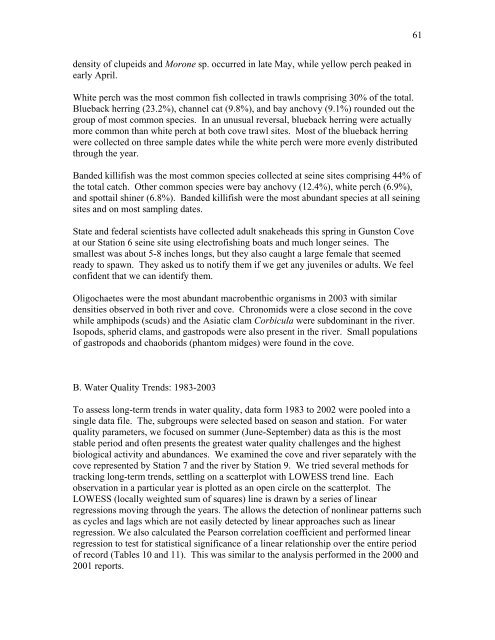NEW: Annual Report - George Mason University
NEW: Annual Report - George Mason University
NEW: Annual Report - George Mason University
Create successful ePaper yourself
Turn your PDF publications into a flip-book with our unique Google optimized e-Paper software.
density of clupeids and Morone sp. occurred in late May, while yellow perch peaked in<br />
early April.<br />
White perch was the most common fish collected in trawls comprising 30% of the total.<br />
Blueback herring (23.2%), channel cat (9.8%), and bay anchovy (9.1%) rounded out the<br />
group of most common species. In an unusual reversal, blueback herring were actually<br />
more common than white perch at both cove trawl sites. Most of the blueback herring<br />
were collected on three sample dates while the white perch were more evenly distributed<br />
through the year.<br />
Banded killifish was the most common species collected at seine sites comprising 44% of<br />
the total catch. Other common species were bay anchovy (12.4%), white perch (6.9%),<br />
and spottail shiner (6.8%). Banded killifish were the most abundant species at all seining<br />
sites and on most sampling dates.<br />
State and federal scientists have collected adult snakeheads this spring in Gunston Cove<br />
at our Station 6 seine site using electrofishing boats and much longer seines. The<br />
smallest was about 5-8 inches longs, but they also caught a large female that seemed<br />
ready to spawn. They asked us to notify them if we get any juveniles or adults. We feel<br />
confident that we can identify them.<br />
Oligochaetes were the most abundant macrobenthic organisms in 2003 with similar<br />
densities observed in both river and cove. Chronomids were a close second in the cove<br />
while amphipods (scuds) and the Asiatic clam Corbicula were subdominant in the river.<br />
Isopods, spherid clams, and gastropods were also present in the river. Small populations<br />
of gastropods and chaoborids (phantom midges) were found in the cove.<br />
B. Water Quality Trends: 1983-2003<br />
To assess long-term trends in water quality, data form 1983 to 2002 were pooled into a<br />
single data file. The, subgroups were selected based on season and station. For water<br />
quality parameters, we focused on summer (June-September) data as this is the most<br />
stable period and often presents the greatest water quality challenges and the highest<br />
biological activity and abundances. We examined the cove and river separately with the<br />
cove represented by Station 7 and the river by Station 9. We tried several methods for<br />
tracking long-term trends, settling on a scatterplot with LOWESS trend line. Each<br />
observation in a particular year is plotted as an open circle on the scatterplot. The<br />
LOWESS (locally weighted sum of squares) line is drawn by a series of linear<br />
regressions moving through the years. The allows the detection of nonlinear patterns such<br />
as cycles and lags which are not easily detected by linear approaches such as linear<br />
regression. We also calculated the Pearson correlation coefficient and performed linear<br />
regression to test for statistical significance of a linear relationship over the entire period<br />
of record (Tables 10 and 11). This was similar to the analysis performed in the 2000 and<br />
2001 reports.<br />
61
















